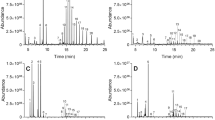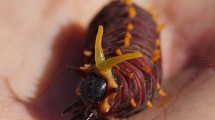Abstract
The ability ofAttacus atlas caterpillars to spray a defensive secretion seems to be due to the fine structure of the integumental glands that produce it. The giant gland cells are fixed to stable cuticular rings surrounding the gland openings and tightly closed by cuticular lids. Probably by increasing hemolymph pressure, the lids are blasted off and the secretion spouts out. The fluid contains several aromatics, biogenic amines (e.g., acetylcholine, histamine), glycerol, and trehalose and exhibits tyrosinase activity. Deterrent effects of caterpillar secretion and hemolymph on predatory ants could be shown. Presumably the spraying process serves to apply the secretion to sensitive sites of vertebrate target organisms.
Similar content being viewed by others
References
Blaich, R. 1978. Analytische Elektrophoreseverfahren. Thieme, Stuttgart.
Budzikiewicz, H., Djerassi, C., andWilliams, D.H. 1967. Mass Spectrometry of Organic Compounds. Holden-Day, San Francisco.
Deml, R., andDettner, K. 1990. Chemical defense ofEudia (Saturnia) pavonia caterpillars.Naturwissenschaften 77:588–590.
Deml, R., andDettner, K. 1993. Biogenic amines and phenolics characterize the defensive secretion of saturniid caterpillars (Lepidoptera: Saturniidae): A comparative study.J. Comp. Physiol. B 163:123–132.
Dettner, K., Fettköther, R., Ansteeg, O., Deml, R., Liepert, C., Petersen, B., Haslinger, E., andFrancke, W. 1992. Insecticidal fumigants from defensive glands of insects—a fumigant test with adults ofDrosophila melanogaster.J. Appl. Entomol. 113:128–137.
Eisner, T. 1970. Chemical defense against predation in arthropods, pp. 157–217,in E. Sondheimer, and B. Simeone (eds.). Chemical Ecology. Academic Press, New York.
Haffer, O. 1921. Bau und Funktion der Sternwarzen vonSaturnia pyri Schiff. und die Haarentwicklung der Saturnidenraupen. Ein Beitrag zu dem Thema: Das Arthropodenhaar.Arch. Naturgesch., Abt. A 87:110–166.
Johnston, G.A.R., Triffett, A.C.K., andWunderlich, J.A. 1968. Identification and estimation of choline derivatives by mass spectrometry.Anal. Chem. 40:1837–1840.
Jones, C.G., Young, A.M., Jones, T.H., andBlum, M.S. 1982. Chemistry and possible roles of cuticular alcohols of the larval Atlas moth.Comp. Biochem. Physiol. 73B:797–801.
McLafferty, F.W., andStauffer, D.B. 1989. The Wiley/NBS registry of Mass Spectral Data. Wiley, New York.
Nässig, W. 1983. Die Praeimaginalstadien vonAttacus caesar Maassen im Vergleich mit einigen verwandten Arten sowie deren Wehrdrüsen (Lep.: Saturniidae).Nachr. Entomol. Ver. Apollo, N.F. 3:129–152.
Nässig, W. 1989. Wehrorgane und Wehrmechanismen bei Saturniidenraupen (Lepidoptera, Saturniidae).Verh. Westd. Entomol. Tag 1988:253–264.
Noirot, C., andQuennedey, A. 1974. Fine structure of insect epidermal glands.Annu. Rev. Entomol. 19:61–80.
Noirot, C., andQuennedey, A. 1991. Glands, gland cells, glandular units: Some comments on terminology and classification.Ann. Soc. Entomol. Fr. (N.S.) 27:123–128.
Paukstadt, U., andPaukstadt, L.H. 1991. Über die Anordnung und Entwicklung von Tuberkeln, Borsten und Wehrdrüsen beiAttacus atlas-Raupen aus westjavanischen Populationen (Lepidoptera: Saturniidae).Entomol. Z. 101:1–32.
Pavan, M., andDazzini, M.V. 1976. Sostanze di difesa dei Lepidotteri. Pubblicazioni dell' instituto di entomologia agraria dell' Universita' di Pavia, 3.
Peigler, R.S. 1989. A revision of the Indo-Australian genusAttacus. Lepidoptera Research Foundation, Beverly Hills.
Stenhagen, E., Abrahamsson, S., andMcLafferty, F.W. 1974. Registry of Mass Spectral Data. Wiley, New York.
Valle, J.R., Picarelli, Z.P., andPrado, J.L. 1954. Histamine content and pharmacological properties of crude extracts from setae of urticating caterpillars.Arch. Int. Pharmacodyn. 98:324–334.
Author information
Authors and Affiliations
Rights and permissions
About this article
Cite this article
Deml, R., Dettner, K. Attacus atlas caterpillars (Lep., Saturniidae) spray an irritant secretion from defensive glands. J Chem Ecol 20, 2127–2138 (1994). https://doi.org/10.1007/BF02066249
Received:
Accepted:
Issue Date:
DOI: https://doi.org/10.1007/BF02066249




